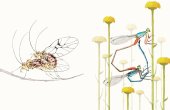The Awe Before There Are Words

To move from speechlessness to speech requires a person — perhaps a wiser part of ourselves — who can hear and receive our experience. As we are heard, we become able to hear our experience ourselves. In the beginning, however, is speechlessness, unformed experience no doubt both beautiful and terrifying. Silence sometimes means that there are no words yet.

Awe touches us even more deeply than a felt love, yet it is deep in darkness. It is not simply unspoken; it is speechless. A friend tells me that she cannot describe her feeling for the natural world as love. It’s not love but awe, she says. She is simply struck speechless at the sight of a heron lifting its wing. Awe-struck, she is incapable of saying more.
In part, awe does not have words because it is utterly private, not “for show.” But it is more than private. It is an involuntary speechlessness. That we seldom find the sense of awe in our talk about the environment may be due in part to our diminished capacity for awe, but it is also due to the inherent speechlessness that awe brings us to. We cannot even put words to it ourselves. It is not surprising that we do not speak of it to others.
Awe is the sense of an encounter with some presence larger than ourselves, mysterious, frightening and wonderful, numinous, sacred. It is the sense of something that we are not capable of containing within our capacity for thought and speech. In awe, one’s self is felt only as something small and incapable, speechless, perhaps graced by the experience but unequal to it.
When a particular emotion has never been felt before, it will not immediately yield its meaning, and the psyche responds with amazement.
Awe makes us feel amazed, astounded, struck dumb. Joseph Campbell’s term aesthetic arrest, which denotes something similar, conveys this sense. We are stopped in our tracks. The words amazed and astounded both suggest a blow to one’s normal mental functioning, as when one is literally stunned or struck or loses one’s normal orientation (as in a maze). In his book “Dream Life,” Donald Meltzer, the influential psychoanalyst, tells the story of a little boy whose therapist, in a gesture out of the ordinary, wiped his face. The boy sat there “amazed.” How are we to understand this? Meltzer quotes from the Talmud, the Jewish book of law: “Stand close to the dying, because when the soul sees the abyss it is amazed.” For the soul of the one dying, death seems an “unbearably new” experience. When a particular emotion has never been felt before, it will not immediately yield its meaning, says Meltzer, and the psyche responds with amazement.
The notion of an experience that does not immediately yield its meaning is the key to the speechlessness of awe in the face of the natural world. While awe stops us in our tracks, this is not the end of our experiencing but rather a beginning. Somehow we intuitively sense that the experience is extraordinarily rich and will require vast transformations of our mental structures as we assimilate it. Our intuition of the long, unknown process ahead stops us cold.
A friend told me that when she first saw Cézanne’s painting “The Bather” in the Museum of Modern Art in New York she experienced the figure in the painting as emerging from the canvas and coming toward her, then moving back, then emerging again. She was awestruck by Cézanne’s capacity to shape space in this way. “It was almost like a bolt of lightning went into me,” she said in recounting the experience. “Some mystery, something entered into me so strongly that it shook me to the bone.” Overwhelmed, she burst into tears and ran out of the museum, feeling she could never do anything comparable. But in the decades since then, that experience of awe has entered into her own unfolding as a painter. “The Man Emerging from Space” is her own name for Cézanne’s painting. In her story we see the painter emerging from the experience of awe.
What allows something in us to develop the potential inherent in the experience of awe is the same process that allows the infant to develop — things are put into words, or otherwise symbolized, by a mind spacious enough to hold or contain the experience. In Wilfred Bion’s model of mental development, the mother, identifying with her infant’s experience in reverie, “holds” it for the infant and gives it meaning in her own mind before communicating it back to the infant. Through this process the infant becomes able to symbolize experience and eventually put it into words. Emotional experience thus becomes usable for growth and development.
As the evolutionary energies of the unbearably new experience do their work, we become capable of putting the experience into words. “I have never told anyone before, but I think you will understand,” poet Kathleen Raine’s mother said to her, as a preface to telling her an experience of awe. She recognized the opportunity — a person who would “understand” — and she made the decision to put the unspoken into words. As we are heard, we become capable both of hearing ourselves, of making the effort to put things into words, and of recognizing a person who can hear. Courage and receptivity develop together. It may take years for awe to bear its fruit, but the self holds something in readiness for a future time.
The process initiated by an encounter with the numinous does not occur without suffering. In some ways, awe and catastrophe are not so different. The experience of awe is so acute because we are at the very edge of awareness, at the edge of our capacity to tolerate the encounter with something so much greater than our present selves, at the edge of our capacity to tolerate our own humility and weakness. The unbearably new with its potential remains unbearable until it has been assimilated. How long could my friend bear her encounter with Cézanne’s “Bather”? She burst into tears and ran out of the museum.
The experience of awe is so acute because we are at the very edge of awareness, at the edge of our capacity to tolerate the encounter with something so much greater than our present selves.
Jung claims that the incarnation of the greater Self in the individual self occurs through suffering. The Bantu peoples of Africa say that unless you find a way to take your tears and add them to the string of tears around your heart, your suffering will be in vain. Finding the meaning of suffering is the process of finding the words for the experience one had, inchoately, in awe — but that process is none other than the process by which one develops the capacity to put experience into words.
Losing the capacity for awe means speechlessness of a different kind — the muteness that signals an incapacity to suffer. The self needs a measure of strength to bear awe and its attendant suffering, strength that comes from the experience of being heard and the struggle for words. Without that strength, it is not possible to make use of the experience of awe. Suffering will then either be avoided altogether, or it will miscarry and turn to bitterness, cynicism, and despair.
The loss of the capacity for awe is not necessarily a permanent loss. As essayist and philosopher Susan Griffin insists, the desire for emotional truth remains, however hidden under silence and muteness. What is held unspoken contains the potential not only for great suffering, but also for numinousness, meaningfulness, and the evolution and development of human beings, individually and collectively.
Shierry Weber Nicholsen is a psychoanalyst in private practice in Seattle and a former faculty member in Antioch University Seattle’s M.A. Program on Environment and Community, teaching environmental philosophy and psychology. She is the author of “Exact Imagination, Late Work: On Adorno’s Aesthetics” and “The Love of Nature and the End of the World: The Unspoken Dimensions of Environmental Concern,” from which this article is excerpted.




